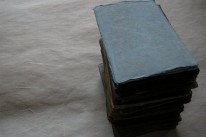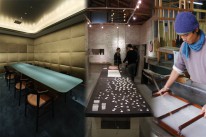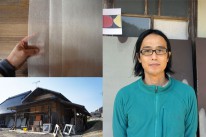Hatano Wataru
Coporate Profille
“Hatano Wataru” was established by Hatano Wataru after completing his training at Kurotani Washi (Japanese paper) in 1997. He studied oil painting at Tama University of Art, but adopt the career of a craftsman after he got involved with Japanese traditional cultures and expressions. It is his innovative concept to blend the beauty of the washi material with furniture, crockery, wallpaper and flooring. His works have been displayed in various individual exhibitions as well as large-scale exhibitions in Tokyo, Kyoto and even overseas.
Story
Kurotani Washi originated 800 years ago as a skill passed on by the fallen samurai. It was later developed as an industry in Kurotani-cho, Ayabe-shi in Kyoto using one of the three greatest natural resources- kozo (a kind of plant). As washi is a type of paper with strong endurance, it is often used to produce items that are close to our daily lives, such as umbrellas, lanterns and shoji wallpaper. Currently, there are about 15 craftsmen working in Hatano Wataru. The local working grounds have contributed greatly to the preservation of the traditional techniques of handmade washi.
Interview
The tradition has been passed down thus far, and it is our responsibility to bring it to the next level. I used to think that tradition preservation just need hard work, but after engaged in this business for 10 years, I realize that there is more to it. We have to be passionate about what washi is, and how we can bring innovations to it, and that is what I am doing now. Washi can be used as wrapping paper or writing paper. Also, by mixing certain amounts of soil into washi, we can change its color and make it resistant against vermiculation. Thus making washi a desirable construction material. We could also add value to Washi or made it personal by drawing on it. I hope to create new cultures of this industry by working with other washi craftsmen, as well as plaster craftsmen and carpenters.
Recommendation
Washi is made in different sizes but the “Kurotani-han” size (490mm x 390mm) is the highly recommended traditional size of Kurotani Washi. The exquisite hand made quality of washi and the flexible size made it ideal material when applies to traditional craftsmanship. Hatano emphasizes his desire to carry on the tradition of washi production.
The Kurotani-han sized washi is highly recommended for people who don’t have much knowledge about Kurotani washi. For the younger generation of people who do not know how to use washi, we give them introductions at exhibitions to show them what is waterproof washi.
Efforts are put into integrating washi into interior designs such as using washi as materials for wallpaper, table surfaces, glass coating and even the inner surface of bath tubs. We hope to cooperate with various related business to meet every demand of our customers.
The biggest size of washi available is 147cm by 72cm. We are currently producing a fusuma-e (a painted fusuma; fusuma are vertical rectangular panels which can slide from side to side to redefine spaces within a room, or act as doors in Japanese architecture), a request by an old temple to produce a fusuma that can last for 300 years.




